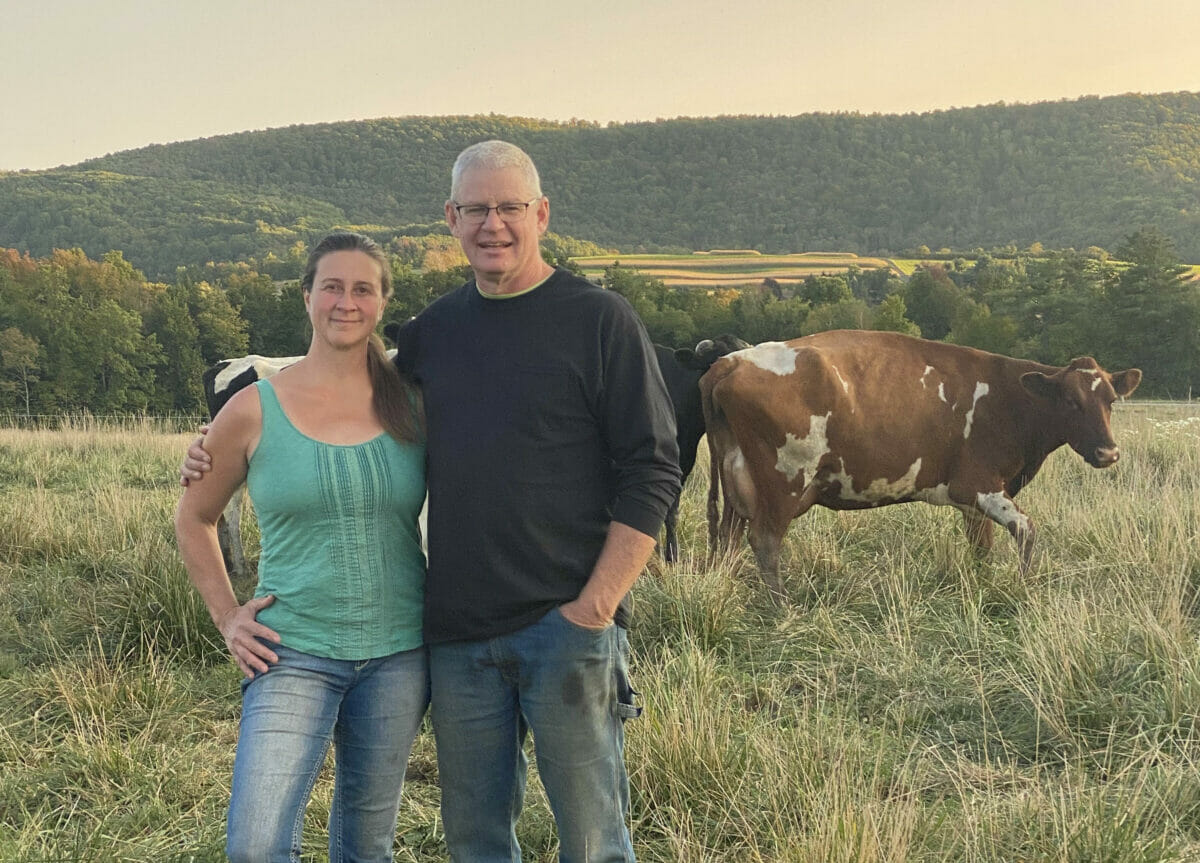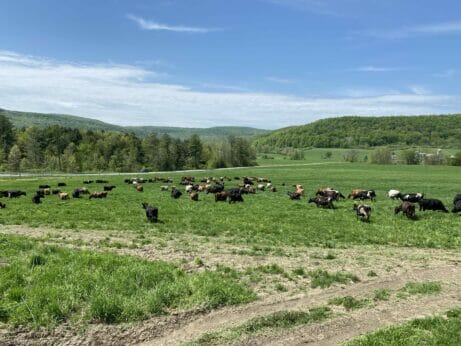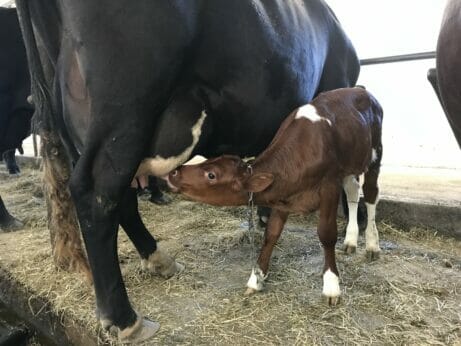Some small farms are rejecting expansion pressure by investing in long-term value. Will funders follow suit?

Dharma Lea, a regenerative grass-fed dairy farm in New York, is operated by Phyllis and Paul Van Amburgh. They milk 200 cows and have little interest in adding more.
Like many small family farms, Dharma Lea has faced relentless pressure to expand, whether it wanted to or not. The farm needs loans, but traditional funders typically build growth into their financing terms. Hitting a wall with conventional funders, the Van Amburghs recently found a loan from a new type of lender.
Pressure to expand
“Farm Credit tells people, ‘Look, we’ll [lend] you more money, but you’ve got to grow, you’ve got to milk more cows’—that’s implicit in their loan agreements,” says Paul. “‘We will finance your next million, but you’re gonna have to put on another 500 cows.’ And now you’ve got farms that are too big to fail. And is that really where we want to go?”
“Every farm started out as a small farm,” says Phyllis. She and Paul tell the story of a farmer, barely making ends meet, who hoped to hit an economy of scale by adding a thousand cows. The way the Van Amburghs see it, the economy of scale is a false hope. If you’re just breaking even with a thousand cows, the situation won’t change with two thousand cows. Phyllis describes the demand to grow as a runaway train of debt.
“We have this old friend who has always milked 20 cows,” says Paul. “He said, ‘I’m losing five dollars a head, milking cows; why would I want to milk more?’ And it was just brilliant. Actually, he understands fixed and variable costs perfectly.”

Cows grazing a field at Dharma Lea Farm.
Depth, not breadth
The Van Amburghs are adamant that the only way off that debt train is long-term investment in quality. When the land and livestock are healthier, a farm needs fewer external inputs, such as fertilizers, feed or antibiotics. And that means fewer variable costs, smoothing the farm’s financial peaks and valleys.
When the Van Amburghs think of debt, they don’t just think of dollars. They think of ecological debt. “When you drive along the road and look at farms, of course, they’re beautiful. But people have no idea how degraded the resource base is. Yes, we purchased land, but we purchased an ecological debt with it. And paying that debt is the difference between surviving and not surviving in agriculture today,” says Paul.
Phyllis says their mentors encouraged them to “look at something bigger than our day-to-day cash flow. And beyond measuring the pounds in the tank—which, I gotta tell you, is a really hard habit to break when that’s what makes the whole thing turn.”
For example, the Van Amburghs learned to raise calves with their mothers. That is considered “blasphemy in the dairy industry,” says Phyllis, because calves drink milk the farm could sell. The practice harms short-term cash flow, but, in the long term, it yields “a cow that will be healthy and strong and live a long time problem-free,” she adds. “You need to invest in yourself first.”
Yet financing is challenging for those seeking organic certification or converting to regenerative agriculture. These approaches require long-term investment in the health of the land that can take years to build, but cash flow on a farm is notoriously short-term.

A calf nurses from its mother at Dharma Lea.
Pro-environment lending
Lenders investing in ecological health and tailoring loans to farms are crucial and scarce, but their numbers are growing. Programs such as the USDA’s Climate-Smart funding embrace farming practices that preserve the health of farmland and the environment. In contrast, traditional lenders favor large-scale monoculture farms, which Paul describes as “the ultimate oversimplification of a biodiverse environment.”
When a lender’s definition of “return on investment” includes environmental impact, it’s more likely that small farms can thrive without getting on the expansion train.
For example, when Walden Mutual Bank evaluates a farm for a loan, the bank looks for a solid return on investment. But it’s not the return you might expect. Walden seeks borrowers making a positive social and environmental impact. Walden, which received FDIC approval in 2022, is the first new mutual bank launched in the Northeast in several generations. It was founded specifically to support sustainable food systems in the region.
Walden was designed for the long run, says its CEO, Charley Cummings. One reason Walden’s founders chose the mutual bank structure was “because it is semi-permanent. Our objective was never to be sold to a global megabank,” says Cummings.
Mutual banks “make a lot of sense,” says Paul, because they have the discretion to be reasonable on rates and flexible terms. This discretion is possible because “nobody’s looking for returns that compete with the stock market.”
Walden lends to farms, like Dharma Lea, that have already embraced sustainable practices. It also seeks farms at the beginning of that journey and tracks their impact over time. Through its annual assessments, Walden collects best practices and shares them with all its agricultural customers. Walden’s borrower assessment uses criteria similar to B Corp certification, focusing on five areas: governance, community, workers, environment and customers.
Dharma Lea is one of Walden’s loan customers. “It’s kind of philosophical how they evaluate. And we need people to acknowledge that our answer to agriculture is real,” says Paul.
Before the advent of Walden and lenders like it, small farms had few loan options to support their sustainable practices. The federal Farm Service Agency (FSA) is considered a lender of last resort, as farms must be declined by three banks before they can apply to the FSA. And Farm Credit, a commercial lending co-operative, is geared toward larger farms.
Investing in the future
Organic certification, like regenerative agriculture, requires short-term financial support to yield a long-term payoff. “Certification requires you to use organic methods for three years. Before you receive organic certification, you incur all the costs of farming organically, but you don’t have any of the benefits in the marketplace. Because you can’t get a premium without that stamp,” Cummings explains.
In addition to newcomer Walden, Rabo AgriFinance in St. Louis offers organic transition loans. And Compeer Financial, a Farm Credit cooperative in the Upper Midwest, makes organic bridge loans. Compeer’s loan offers interest-only payments during the transition period and converts to a standard term loan once the farm is certified. The USDA’s Transitional and Organic Grower Assistance Program provides a $5 per acre subsidy during the transition, but it requires participants to purchase additional insurance.
Walden sees the Northeast as a perfect fit for this new type of financing. “In the last five to ten years, there has been this amazing renaissance of small-scale agriculture here. This is quickly becoming the center of the local food movement,” says Cummings.
Farming for impact
The Van Amburghs have five children, and they want to pass down not only the resource base of the farm but a healthier environment and climate. They see appropriate financing as a crucial part of the picture. “Farmers need help. If we gave people a bridge to transition, and we properly incentivized, a lot of very conventionally minded, linear-thinking farmers would become amazingly regenerative,” says Paul.
Makes perfect sense!!! Such a complex situation that we consumers have really no idea about! 🤷♀️🙌
More Techniques of permaculture towards Circular Economy is required In achieving the milestones of organic farming .
It is my sincere opinion that developing countries should be assisted in dairy farming and I will not subscribe to cash donations. We can have such arrangements that farm owner in developing economies work with big advance farm, exchanging staff, work idea modern ways and above all, introduction and application to ICT, IoT and Artificial Intelligence.
Farms and farmers that have high prosperity for growth should be introduced to FUNDING/DEVELOPMENT
or DONOR AGENCIES and should be properly monitored.
The level of malnutrition is very high and a lot of these countries spends billions of dollars annually on diary products.